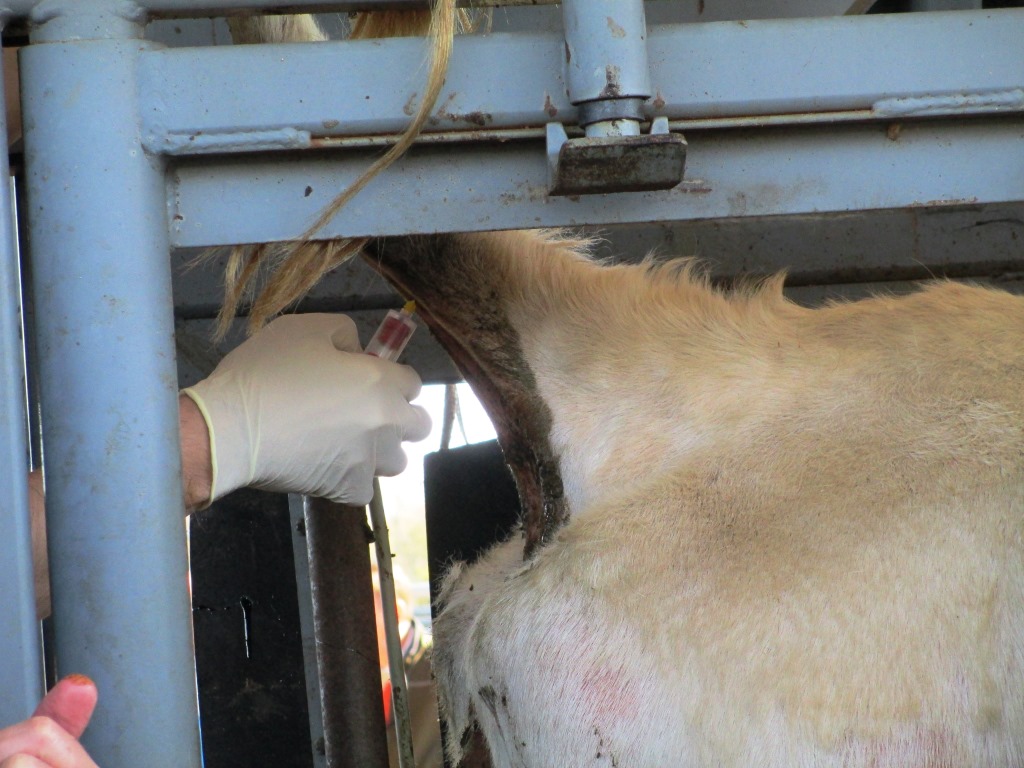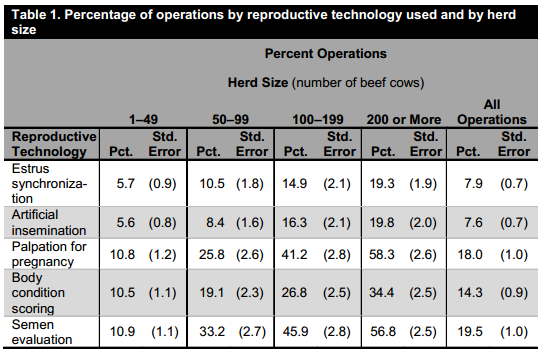 Pregnancy testing is one of the best management practices cattle ranchers can use to reduce costs and improve the efficiency of their beef herd. Livestock economists in the southeast estimate that the annual production costs are $400 or more per brood cow each year. Open or non-pregnant cows will consume considerable resources, if you wait until the end of the calving season to cull them. Pregnancy testing results provide ranchers valuable information so they can optimize their pasture, feed, and other resources for the cows that will produce a calf to sell.
Pregnancy testing is one of the best management practices cattle ranchers can use to reduce costs and improve the efficiency of their beef herd. Livestock economists in the southeast estimate that the annual production costs are $400 or more per brood cow each year. Open or non-pregnant cows will consume considerable resources, if you wait until the end of the calving season to cull them. Pregnancy testing results provide ranchers valuable information so they can optimize their pasture, feed, and other resources for the cows that will produce a calf to sell.
According to the 2008 USDA’s National Animal Health Monitoring System (NAHMS) survey, only 18% of U.S. Cow-calf operations utilize pregnancy testing to manage their herds, yet 82% control internal parasites. Certainly internal parasites reduce the productivity of a cow herd, but so does feeding open cows. So why don’t more cattlemen have their cows tested for pregnancy? The difference in these two proven management practices may well be that ranchers can buy the deworming products and do this practice themselves. Pregnancy testing has been a practice that only trained veterinarians and technicians could do until only recently.
New technology has been developed to rapidly test cattle and other ruminants for pregnancy with a simple blood test. Now ranchers can simply draw 2 cc’s of blood and ship it to a lab for analysis, with results available within 27 hours of the lab receiving the sample. There are several labs that can analyze blood for the presence of pregnancy associated glycoproteins. The tests are 97-99% accurate, if they are taken at the right time. The test must be taken at least 30 days after breeding or 30 or more days after the bulls come out of the breeding herd. Cows that have calved and are lactating will also have the pregnancy proteins in their blood for up to 90 days after calving and will provide a false reading. Therefore, the test must be given 90 days after calving and 30 days post-breeding.
Hiring a veterinarian to do pregnancy testing does have some advantages over the blood sample technique. Experienced veterinarians can detect pregnancies 35-45 days after breeding, with no restrictions on previous calving date. The results are provided right away and allow for immediate action while the cow is still in the cowpens. They can also provide an estimate of the age of the fetus, which offers an estimated calving date. Blood samples have to be shipped and then analyzed for 27 hours at the lab, so the cows would have to be brought back to the pens for sorting. The results are simply yes or no with no age estimate. Drawing blood samples, however is a much easier skill to master than rectal palpation, so ranchers can do this themselves. Both methods, however are an effective management tool worth considering.
Here is an example of how blood test pregnancy testing might be used to better manage a commercial herd. Let’s say our herd has a 90 day breeding season of January 1 – March 31. That would result in a calving season of approximately October 10 through January 7. The cows in this herd would not provide a false reading after April 7, but this would not be 30 days post-breeding, so the blood test would have to be given after April 30. In this example ranchers could identify open or non-pregnant cows by the middle of May, and manage these cows accordingly. Replacement heifers and open cows without calves nursing at side could be sold immediately. Open cows with nursing calves could be sorted off and sold at weaning. Knowing the number of replacements needed to maintain herd size in May provides more preparation time to identify and raise replacements heifers, or find a suitable source for purchasing them. The main point is to have the information needed to conserve grazing and feed resources for the most productive cows.
There are two main companies that offer blood test pregnancy diagnosis. The cost of the actual lab test varies from as $2.50 to $3.50 per head based on the lab you choose and the number of samples submitted. In addition, there is also the cost of the blood tubes, needles, and the cost of shipping. Some labs provide complete testing kits that have all of the supplies needed, others only provide the testing and require purchasing of supplies from a veterinary supply company.
For more specific information on blood sample pregnancy testing service for cattle and other ruminants, go to the following websites:
Their Florida Affiliate: Central Florida Large Animal Veterinary Services
 1
1

